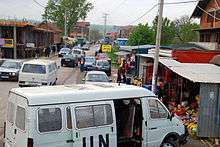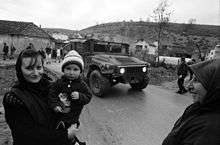Serbian enclaves in Kosovo


Serbian enclaves refers to settlements in Kosovo[a] outside North Kosovo ("south of the Ibar") where Serbs form a majority. The term does not include North Kosovo with a compact Serb majority, in which Kosovo institutions are still not fully operational. After the initial outflow after the Kosovo War the situation of the Kosovo Serb communities has improved and under the Ahtisaari plan minority rights have been promoted.[1]
Serbs have often built roadblocks and barricades, to prevent access by Kosovo Police and customs officers.[2] The 2013 Brussels Agreement allowed full operation of Kosovo Police and customs officials.
After the 2013 Brussels Agreement between the governments of Kosovo and Serbia, Serbia recognised the municipalities and the Republic's governance of the territory, and agreed to create an association of Serb-majority municipalities, which will operate within the Kosovan legal framework.
History
According to the 1991 census in Yugoslavia, there were five municipalities with a Serb majority in the Autonomous Province of Kosovo and Metohija. Those were: Leposavić, Zvečan, Zubin Potok, Štrpce and Novo Brdo. The remaining municipalities had an Albanian majority. Other significant ethnic minority in Kosovo were Muslims by nationality (today mostly identify as Bosniaks), and Roma who did not form majority in any of the municipalities. The 1991 census was boycotted by most Albanians., and is generally seen as unreliable.

Prior to the 1999 Kosovo War, there were many more Serbs living in the territory of Kosovo. Many of them left in 1999, and some more left during the 2004 unrest, when cultural and architectural heritage of the Serb people was targeted, and as a result 35 churches, including 18 monuments of culture, were demolished, burnt or severely damaged. Estimates of the number of Serbs thus displaced range from 65,000 to 250,000[3][4][5][6][7][8][9][9][10][11] Only about 3.000 of them have returned since. Based on Serbian former Ministry for Kosovo and Metohija, 312 of 437 towns and villages in which Serbs lived were completely ethnically cleansed, and in the ensuing violence, more than 1.000 Serbs were killed, while 841 were kidnapped and 960 wounded.[12][13]
Between 2000 and 2008, the UNMIK administration created eight new municipalities on the territory of Kosovo. Three of those new municipalities have an ethnic Serb majority: Gračanica, Klokot-Vrbovac and Ranilug. This move is not recognized by the Government of Serbia. In 2008, the Community Assembly of Kosovo and Metohija was created to coordinate the efforts of the Serbian minority in Kosovo. There are some 120,000 Serbs in Kosovo, of whom about a third are in the north. They believe that if Kosovar government officials are deployed on the border, Kosovo will eventually take control of the north, which is now a de facto part of Serbia. Kosovo's Serbs, especially in the north, reject its independence.[2]
During the ethnic tensions in the 2004 unrest in Kosovo, numerous Serb enclaves were assaulted by Kosovo Albanian rioters.
Demographics
Municipalities

According to the 2011 census, which was boycotted in North Kosovo and partially boycotted by Serbs in southern Kosovo,[14] the municipalities of Gračanica, Parteš and Ranilug (enclaves, outside North Kosovo) have a Serb majority, while Serbs form about 45% of the total population of Novo Brdo, Štrpce and Klokot.[15]
Towns and villages
- Vučitrn municipality: Gojbulja, Panjetina, Prilužje (more than 3,000 Serbs), Grace
- City of Pristina: Plemetina, Gračanica
- Lipljan municipality: Dobrotin, Livađe, Donja Gušterica, Gornja Gušterica, Suvi Do, Staro Gracko, Novo Naselje
- Kosovo Polje municipality: Batuse
- Gnjilane municipality: Šilovo, Pasjane, Parteš (new municipality), Koretište, Donja Budriga, Stanišor, Kusce, Straža, Kmetovce,[16] Poneš[16]
- Peć municipality: Goraždevac;[17] plurality: Belo Polje
- Istok municipality: Osojane, Crkolez
- Orahovac municipality: Velika Hoča (1,200 Serbs), Orahovac (1,100 Serbs)
- Skenderaj municipality: Banja, Suvo Grlo
- Kosovska Kamenica municipality:[18] Ranilug, Ropotovo, Donje Korminjane
- Vitina municipality: Klokot, Vrbovac, Trpeza, Požaranje, Novo Selo, Žitinje
- Novo Brdo municipality: Prekovce
- Klina municipality: Vidanje[19]
- Suva Reka municipality: Popovljane, Dvorane, Delovce; plurality: Mušutište, Topličane
Smaller Serbian communities are also present in Prizren, Gnjilane and Obilić.
Serbian-language media in enclaves
See also
- Serbs in Kosovo
- Enclave (2015 drama film)
- Kosovo war
Notes and references
- Notes
| a. | ^ Kosovo is the subject of a territorial dispute between the Republic of Kosovo and the Republic of Serbia. The Republic of Kosovo unilaterally declared independence on 17 February 2008, but Serbia continues to claim it as part of its own sovereign territory. The two governments began to normalise relations in 2013, as part of the Brussels Agreement. Kosovo has received recognition as an independent state from 110 out of 193 United Nations member states. |
- References
- ↑ "Serb community in Kosovo" (PDF). Helsinki Committee for Human Rights in Serbia. June 2012. p. 11. Retrieved 23 September 2012.
- 1 2 "Serbia and Kosovo: On the border of conflict". The Economist. 21 November 2011. Retrieved 23 September 2012.
- ↑ European Stability Initiative (ESI): The Lausanne Principle: Multiethnicity, Territory and the Future of Kosovo's Serbs (.pdf) , 7 June 2004.
- ↑ Coordinating Centre of Serbia for Kosovo-Metohija: Principles of the program for return of internally displaced persons from Kosovo and Metohija.
- ↑ UNHCR: 2002 Annual Statistical Report: Serbia and Montenegro, pg. 9
- ↑ US Committee for Refugees and Immigrants (USCRI): Country report: Serbia and Montenegro 2006.
- ↑ "Kosovo: The Human Rights Situation and the Fate of Persons Displaced from Their Homes (.pdf) ", report by Alvaro Gil-Robles, Council of Europe Commissioner for Human Rights, Strasbourg, 16 October 2002, p. 30.
- ↑ UNHCR, Critical Appraisal of Responsee Mechanisms Operating in Kosovo for Minority Returns, Pristina, February 2004, p. 14.
- 1 2 US Committee for Refugees (USCR), April 2000, Reversal of Fortune: Yugoslavia's Refugees Crisis Since the Ethnic Albanian Return to Kosovo, p. 2–3.
- ↑ "Kosovo: The human rights situation and the fate of persons displaced from their homes (.pdf) ", report by Alvaro Gil-Robles, Council of Europe Commissioner for Human Rights, Strasbourg, 16 October 2002.
- ↑ International Relations and Security Network (ISN): Serbians return to Kosovo not impossible, says report (.pdf) , by Tim Judah, 7 June 2004.
- ↑ B92: Interesovanje za povratak na Kosovo (The Interest for Returning to Kosovo), 8 Jun 2009 (Serbian)
- ↑ "Raseljeni Srbi žele povratak na Kosovo". RTS. 8 Jun 2009. Retrieved 23 September 2012.
- ↑ "ECMI: Minority figures in Kosovo census to be used with reservations". ECMI.
- ↑ "REKOS 2011: Results". Statistical Office of Kosovo. September 2012. Retrieved 22 September 2012.
- 1 2 Blic:"Struja se mora plaćati", 15. 05. 2009. (Serbian)
- ↑ Glas Javnosti: Setva u okruženju, 1 Apr 2000 (Retrieved 29 Nov 2010) (Serbian)
- ↑ B92: Sukob Srba i KPS-a na protestima, 10 May 2009 (Serbian)
- ↑ B92: Zadušnice na Kosovu, 6 Jun 2009(Serbian)